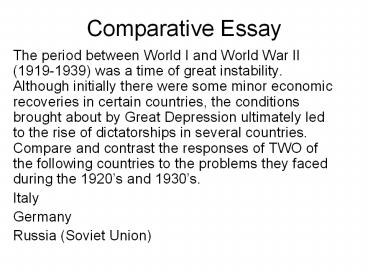Comparative Essay PowerPoint PPT Presentation
Title: Comparative Essay
1
Comparative Essay
- The period between World I and World War II
(1919-1939) was a time of great instability.
Although initially there were some minor economic
recoveries in certain countries, the conditions
brought about by Great Depression ultimately led
to the rise of dictatorships in several
countries. Compare and contrast the responses of
TWO of the following countries to the problems
they faced during the 1920s and 1930s. - Italy
- Germany
- Russia (Soviet Union)
2
Thesis Statement
- 1. Must state your major points of comparison AND
be supported by specific historical evidence. - 2. Answers all parts of the question.
- 3. Makes at least (2) direct and relevant
comparisons of the given societies. - 4. Analyze relevant reasons for similarities and
differences.
3
COMPARATIVE RUBRIC-Thesis Statement
- Has an acceptable Thesis Makes direct
comparisons between regions and identifies
specific similarities AND differences Explains
REASONS for the similarities and differences
identifies time frame. - Has a thorough and analytical Thesis Has ALL of
the elements of an acceptable thesis but is done
with exceptional style and detail. - Has a weak or faulty Thesis Is missing ONE or
more the essential elements listed above for an
acceptable thesis.
4
Focus What is the fine art of compare and
contrast?
- What the AP World History will ask you to
compare - How different societies responded to events, to
each other, or to other societies. - How different societies changedor didntin
response to an event. - How different societies developed
- How different societies responded to new
technologies or new ideas.
5
Sample Thesis Format
- Although there were certain (similarities/differen
ces) between (list the places you are comparing)
with regard to (name the things/ideas/events,
etcyou are comparing) during (list time frame)
they were very (similar/different)with regards to
(list the SPECIFIC similarities/differences.)
Despite these (similarities and differences) they
were (the same or different ) in the following
ways. (list the ways they were similar/different).
The following factors (list the factors)
largely account for these similarities and
differences.
6
Comparative Rubric Body How to Address Parts
of Question
- Addresses ALL parts of the question, in a mostly
balanced fashion. Must include SEVERAL examples
of evidence of analysis continuity and change,
cause and effect relationships, interactions) - Addresses ALL parts of the question, although not
thoroughly or in a balanced fashion. Must
include SOME evidence of analysis continuity and
change, cause and effect relationships,
interactions) - Addresses MOST parts of the questions, but does
not address BOTH similarities AND differences.
However, includes SEVERAL examples of evidence of
analysis continuity and change, cause and effect
relationships, interactions) - Addresses MOST parts of the questions, but does
not address BOTH similarities AND differences.
However, includes SOME examples of evidence of
analysis continuity and change, cause and effect
relationships, interactions) - Addresses MOST parts of the questions, but does
not address BOTH similarities AND differences.
FEW, FAULTY OR NO examples of evidence of
analysis continuity and change, cause and effect
relationships, interactions)
7
Comparative Rubric Body-Historical Evidence
- Supports your thesis with SEVERAL EXAMPLES of
appropriate historical evidence (3 or more). - Supports your thesis with SOME appropriate
historical evidence (at least 2). - Does not include at least 2 strong and relevant
pieces of historical information to support the
thesis. Examples are overly general or not
strongly connected to the quesiton or an
analytical point you are making.
8
Compartive Rubric Body-Direct Comparisons
- Makes at least TWO or more direct, specific and
relevant comparisons between your assigned
regions. - Makes at least ONE specific and direct comparison
between your assigned regions. May state several
similarities and differences, but does not
connect the ideas through direct comparisons. - Attempts to compare but is overly vague perhaps
simply lists how things were in one area, how
things were in another area and does not make the
connections between the information in the form
of a DIRECT COMPARISON.
9
Is this a DIRECT comparison?
- What are the major similarities and differences
regarding the health benefits of apples and
oranges? - Apples are red and include a great deal of pectin
and fiber which are known to be beneficial to our
health. Oranges are orange and include a great
deal of vitamin C as well as abundant fiber.
10
Comparative Rubric BodyReason(s) for
similarities and differences
- Explains at least ONE or more reasons for the
similarities and/or differences between the
regions. - Makes no attempt or does not correctly or clearly
identify the reasons for the similarities and/or
differences.

